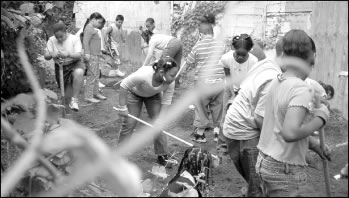By Carolyn Ratcliffe
Have you noticed over the past several years how many of the old Lower East Side shops have vanished? Where are the butcher, the fishmonger, the baker, the bookstores, the antiques-and-collectables boutiques and a variety of other small locally owned shops? On major holidays, fewer people are seen on the avenues, where before there was always a mix of ages, ethnicities, races, well-to-do, middle-income and poor present — ordinary people going about their daily lives, doing groceries, laundry, food shopping, eating out and just passing the time.
Querying my neighbors here on E. Ninth St., others at a garden meeting and several art openings, I asked what changes they had noticed the most. The overwhelming majority said: Noise from the patrons visiting local nightspots, their lack of common courtesy — ignoring polite salutations and/or requests, lack of awareness of others on the street and in buildings by blocking the passage on the sidewalk or in hallways while texting or talking to friends on their cell phones, unaware of how loud they are.
Many local residents know each other from countless events. Everyone always seemed to be on the way to a meeting: Tenants, building, block, garden, community board, arts, political, preservation, religious or 12-step — you name it, we had a meeting about it. And, as a result, there was a large population around who knew one another by sight, frequently by name, and we usually said hello (even when we did not agree on anything). It was different than many other neighborhoods in the city, where one’s anonymity is treasured and cultivated, where it is fashionable not to acknowledge anyone outside of work or personal friends. Not so here. It was and, in some ways still is, a true “village” where your neighbors know who you are.
More recently, we seem to be inundated with a disproportionate number of people here for a short period of time, many typically sharing what is a small, two-bedroom apartment with three others. It is surmised that many of them are students, as they vanish when the holidays arise and it becomes noticeably quiet on the avenues. However, when present, some are plugged in to a variety of devices and tuned out to their surroundings. Often in the evening, they seem to have a herd instinct, walking the street in clutches, talking at the top of their voice range, coming to a dead halt in the middle of the entrance to the crosswalk, talking, texting and totally oblivious to anyone else trying to get out of the crosswalk onto the sidewalk. Third Ave. has become a vast student center of sorts with the numerous dorms that rise above Third Ave. from E. Ninth St. to E. 14th St. Other students live in older buildings spread throughout the neighborhood where they get socialized by the older tenants, who are quick to advise, “Don’t make so much noise on the stairwell,” and “Keep parties down to a dull roar as the airshafts amplify the sound and project it into all of the adjoining apartments.”
Gone is “Alphabet City” and, rising from its ashes, “The East Village” beckons to many. Gone are the frequent fires in the buildings and the garbage cans, and gone are many of the homeless. Community gardens are lush, green spaces, not the rubble-filled lots of the late ’70s early ’80s, when so many of us worked on weekends and any other spare time we had, to turn these lots into the pleasant vistas they are now. One garden even hosts nonprofits’ catered, sit-down dinners, under a tent, no less.
Many older tenement buildings now look well maintained, and then there is the ever-present new construction. Yet, little did we know when we were working to revitalize the neighborhood, clean up and organize with thousands of hours of volunteer work to improve our buildings, our schools and our streets, that we would one day be considered “deadwood,” waiting to be “pruned” by developers who want make a quick-profit turnaround with a new dorm or hotel. One neighbor was even accosted in the local dog run and told, “It is because of people like you”(rent-stabilized tenant equals endangered species) “that everyone else had to pay high rents.”
Surely, there is room for both revitalizing the economy and the neighborhood without destroying the very core of what made it one of the most eclectic, vital and creative neighborhoods in New York. Many residents are artists, musicians/composers, poets, writers, photographers and filmmakers who thrive on the diversity and vitality of the streets. They have helped to bring this recovery about and should be viewed as assets rather than “deadwood.”
On a positive note, our electeds are helping! Legislation was enacted in March 2008 to stop harassment of legal tenants and ensure that protections are in place when new market-rate developments go up.





































